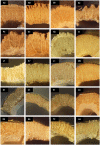A Belated Green Revolution for Cannabis: Virtual Genetic Resources to Fast-Track Cultivar Development
- PMID: 27524992
- PMCID: PMC4965456
- DOI: 10.3389/fpls.2016.01113
A Belated Green Revolution for Cannabis: Virtual Genetic Resources to Fast-Track Cultivar Development
Abstract
Cannabis is a predominantly diecious phenotypically diverse domesticated genus with few if any extant natural populations. International narcotics conventions and associated legislation have constrained the establishment, characterization, and use of Cannabis genetic resource collections. This has resulted in the underutilization of genepool variability in cultivar development and has limited the inclusion of secondary genepools associated with genetic improvement strategies of the Green Revolution. The structured screening of ex situ germplasm and the exploitation of locally-adapted intraspecific traits is expected to facilitate the genetic improvement of Cannabis. However, limited attempts have been made to establish the full extent of genetic resources available for pre-breeding. We present a thorough critical review of Cannabis ex situ genetic resources, and discuss recommendations for conservation, pre-breeding characterization, and genetic analysis that will underpin future cultivar development. We consider East Asian germplasm to be a priority for conservation based on the prolonged historical cultivation of Cannabis in this region over a range of latitudes, along with the apparent high levels of genetic diversity and relatively low representation in published genetic resource collections. Seed cryopreservation could improve conservation by reducing hybridization and genetic drift that may occur during Cannabis germplasm regeneration. Given the unique legal status of Cannabis, we propose the establishment of a global virtual core collection based on the collation of consistent and comprehensive provenance meta-data and the adoption of high-throughput DNA sequencing technologies. This would enable representative core collections to be used for systematic phenotyping, and so underpin breeding strategies for the genetic improvement of Cannabis.
Keywords: cannabinoids; genetic conservation; industrial hemp; marijuana; phenotypic variation; plant breeding.
Figures



Similar articles
-
Developmental Plasticity of the Major Alkyl Cannabinoid Chemotypes in a Diverse Cannabis Genetic Resource Collection.Front Plant Sci. 2018 Oct 23;9:1510. doi: 10.3389/fpls.2018.01510. eCollection 2018. Front Plant Sci. 2018. PMID: 30405660 Free PMC article.
-
Enhancement of Plant Productivity in the Post-Genomics Era.Curr Genomics. 2016 Aug;17(4):295-6. doi: 10.2174/138920291704160607182507. Curr Genomics. 2016. PMID: 27499678 Free PMC article.
-
Genebank Phenomics: A Strategic Approach to Enhance Value and Utilization of Crop Germplasm.Plants (Basel). 2020 Jun 29;9(7):817. doi: 10.3390/plants9070817. Plants (Basel). 2020. PMID: 32610615 Free PMC article. Review.
-
Genomic characterization of a core set of the USDA-NPGS Ethiopian sorghum germplasm collection: implications for germplasm conservation, evaluation, and utilization in crop improvement.BMC Genomics. 2017 Jan 26;18(1):108. doi: 10.1186/s12864-016-3475-7. BMC Genomics. 2017. PMID: 28125967 Free PMC article.
-
Core Collections: Is There Any Value for Cotton Breeding?Front Plant Sci. 2022 Apr 28;13:895155. doi: 10.3389/fpls.2022.895155. eCollection 2022. Front Plant Sci. 2022. PMID: 35574064 Free PMC article. Review.
Cited by
-
A marijuana-drug interaction primer: Precipitants, pharmacology, and pharmacokinetics.Pharmacol Ther. 2019 Sep;201:25-38. doi: 10.1016/j.pharmthera.2019.05.001. Epub 2019 May 7. Pharmacol Ther. 2019. PMID: 31071346 Free PMC article. Review.
-
Industrial hemp seed: from the field to value-added food ingredients.J Cannabis Res. 2022 Jul 29;4(1):45. doi: 10.1186/s42238-022-00156-7. J Cannabis Res. 2022. PMID: 35906681 Free PMC article. Review.
-
Cannabis, from plant to pill.Br J Clin Pharmacol. 2018 Nov;84(11):2463-2467. doi: 10.1111/bcp.13618. Epub 2018 May 24. Br J Clin Pharmacol. 2018. PMID: 29701252 Free PMC article. Review.
-
Comparative genomics of flowering behavior in Cannabis sativa.Front Plant Sci. 2023 Jul 27;14:1227898. doi: 10.3389/fpls.2023.1227898. eCollection 2023. Front Plant Sci. 2023. PMID: 37575928 Free PMC article.
-
Large-scale whole-genome resequencing unravels the domestication history of Cannabis sativa.Sci Adv. 2021 Jul 16;7(29):eabg2286. doi: 10.1126/sciadv.abg2286. Print 2021 Jul. Sci Adv. 2021. PMID: 34272249 Free PMC article.
References
-
- Amaducci S., Scordia D., Liu F. H., Zhang Q., Guo H., Testa G., et al. (2014). Key cultivation techniques for hemp in Europe and China. Ind. Crops Prod. 68, 2–16. 10.1016/j.indcrop.2014.06.041 - DOI
-
- Babic V., Vančetović J., Prodanović S., Kravić N., Babić M., Andelković V. (2015). Numerical classification of Western Balkan drought tolerant maize (Zea mays L.) landraces. J. Agric. Sci. Technol. 17, 455–468.
-
- Bassani M., Pacini E., Franchi G. G. (1994). Humidity stress responses in pollen of anemophilous and entomophilous species. Grana 33, 146–150. 10.1080/00173139409428991 - DOI
Publication types
LinkOut - more resources
Full Text Sources
Other Literature Sources

